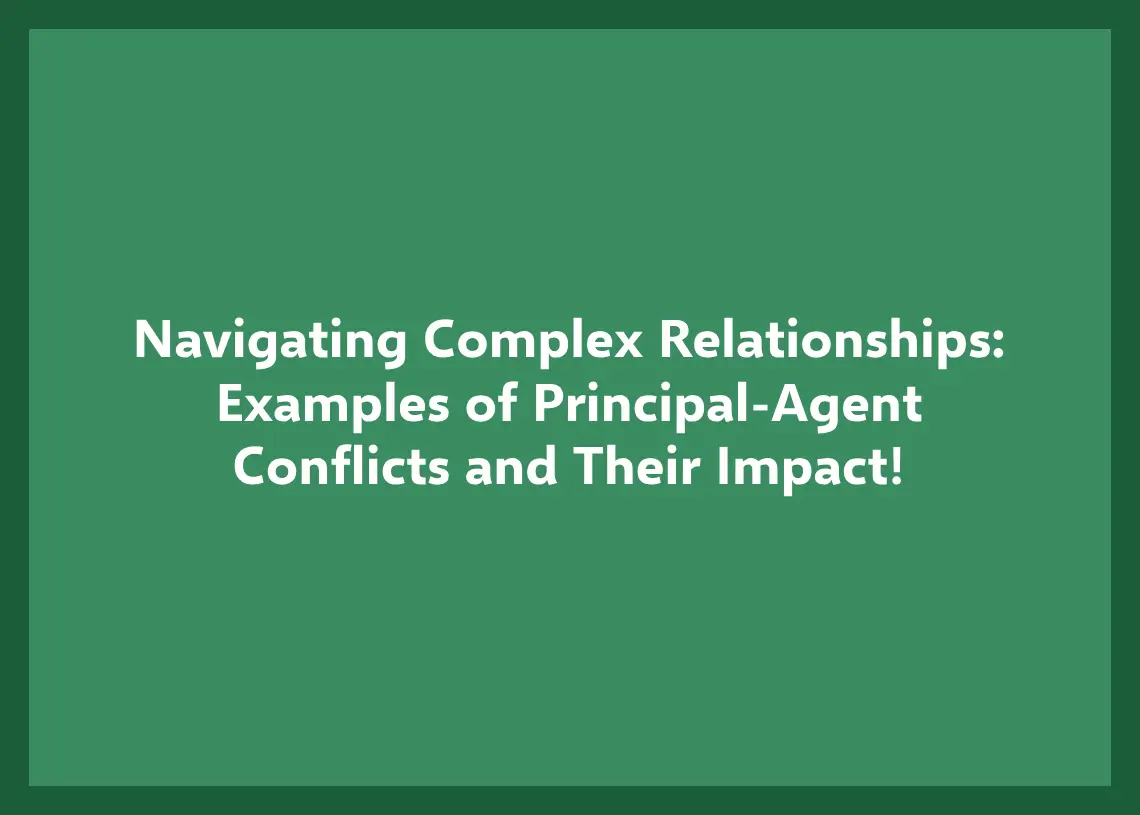Principal-agent conflicts are a common occurrence in the business world, and they can have significant consequences for all parties involved. These conflicts arise when a principal hires an agent to act on their behalf, but the interests of the agent do not align with those of the principal. In such cases, the agent may act in their own self-interest, which can be detrimental to the principal’s goals. This conflict can occur in various industries, including finance, healthcare, and politics, and can lead to mistrust, loss of revenue, and even legal action.
Understanding the nature of principal-agent conflicts is crucial for any business owner, manager, or investor. It helps to identify potential conflicts and take proactive steps to mitigate them. In this blog post, we will explore some common examples of principal-agent conflicts and their impact on businesses. From executives mismanaging company finances to doctors prescribing unnecessary treatments, we will delve into real-life scenarios where the interests of principals and agents have clashed.
Earn a certificate in your dream career for an affordable price at IAP Career College today!
Misaligned incentives create conflicts
One of the most common examples of principal-agent conflicts is the issue of misaligned incentives. When the goals of the principal and agent are not in harmony, it can lead to conflicts and misunderstandings. For instance, a company’s shareholders may want to maximize profits, while the managers may be more focused on maximizing their own salaries and bonuses.
This misalignment of incentives can create conflicts and lead to decisions that benefit the managers at the expense of the shareholders. Additionally, in the healthcare industry, doctors may have incentives to order more tests and procedures, even if they are not necessary, in order to increase their income.
This can lead to unnecessary expenses for patients and insurers. It is crucial to identify and address these misaligned incentives in order to prevent conflicts and ensure that both parties are working towards the same goals.
Agents prioritize self-interest over principals
One common example of a principal-agent conflict is when an agent prioritizes their own self-interest over that of the principal they represent. This can occur in various professional settings, such as a financial advisor investing in high-risk stocks for their own profit rather than what is best for their client’s portfolio.
Another example is a real estate agent pushing for a quick sale to receive a commission, even if it is not in the best interest of the seller. These scenarios highlight the importance of establishing clear expectations and incentives for agents to align their interests with those of their principals.
Effective communication and transparency are critical to mitigate the risks of principal-agent conflicts and maintain trust and accountability in professional relationships.
Agents hide information from principals
One of the most common examples of principal-agent conflicts is when agents hide information from principals. Agents are typically individuals or entities that act on behalf of the principal, and they are expected to act in the best interests of the principal.
However, in some cases, agents may hide information from the principal in order to gain a personal advantage or protect their own interests. For example, a financial advisor may recommend investments that are not in the best interests of the client but rather benefit the advisor in terms of commissions or fees.
This can result in a conflict of interest and ultimately harm the principal. It is important for principals to establish clear communication channels with their agents and monitor their actions to ensure that they are acting in the best interests of the principal.
Principals lack control over agents
One of the most common examples of principal-agent conflicts is the lack of control that principals have over their agents. This occurs when agents, who are hired to act on behalf of principals, act in their own interests rather than the interests of their principals.
This conflict arises due to the differing goals of principals and agents. While principals are interested in maximizing profits and value, agents are often more interested in their own personal gain, such as bonuses or promotions.
This misalignment of goals can lead to agents making decisions that are not in the best interests of the principals, which can ultimately harm the company as a whole. In order to mitigate this conflict, principals should establish clear guidelines and performance metrics, as well as providing incentives for agents to act in the best interests of the company.
Additionally, regular monitoring and communication between principals and agents can help to prevent conflicts and ensure that everyone is working towards the same goals.
Agents act against the principal’s wishes
Examples of Principal-agent conflicts can arise when the agent acts against the wishes of the principal. This can happen for a number of reasons, including misalignment of incentives between the two parties, a lack of communication or transparency, or conflicting priorities.
For instance, an investment advisor may recommend investments that benefit them more than the principal, or a real estate agent may push for a sale that is not in the best interests of the seller. These conflicts can lead to a breakdown of trust between the principal and agent and can have negative consequences for both parties.
To mitigate these conflicts, it is important for principals to carefully vet their agents and establish clear expectations and communication channels, and for agents to act with integrity and prioritize the interests of their clients.
Agents shirk their responsibilities
One of the most common examples of principal-agent conflicts is when agents shirk their responsibilities. This occurs when the agent fails to act in the best interests of the principal or fails to fulfill the obligations outlined in the contract.
For instance, an employee may intentionally underperform their duties to avoid additional responsibilities or workload. Similarly, a financial advisor may recommend investments that generate higher commissions for themselves, rather than investing in the best interests of their client.
In both cases, the agent prioritizes their own interests over those of the principal, resulting in a conflict of interest. To mitigate this conflict, principals can implement monitoring mechanisms, such as regular performance evaluations and audits, to ensure agents are fulfilling their contractual obligations.
Agents engage in moral hazard
One of the most common examples of principal-agent conflicts is the issue of moral hazard. This occurs when agents are incentivized to take risks that benefit themselves at the expense of the principal. In other words, agents have an incentive to engage in behavior that is not in the best interest of the principal, due to the fact that they are not bearing the full cost of their actions.
For example, salespeople may push for higher commissions by selling products that are not suitable for the customer’s needs. This can result in a loss of trust and reputation for the principal, as well as financial losses. In order to mitigate this issue, principals can implement monitoring and incentive structures that align the interests of both parties, thereby reducing the likelihood of moral hazard.
Agents engage in adverse selection
Principal-agent conflicts are a common occurrence in the business world, particularly when it comes to hiring agents to act on behalf of principals. One of the most significant issues that can arise in such situations is adverse selection, which occurs when an agent with hidden information takes actions that are detrimental to the principal’s interests.
This can happen in a wide range of contexts, but one common example is in insurance, where people with higher risk levels are more likely to buy coverage, while those with lower risk levels are less likely to do so. In such cases, insurance companies may find themselves insuring an increasingly risky pool of clients, which can lead to higher premium rates and lower profits.
To mitigate such risks, principals must carefully screen and monitor their agents, and put in place safeguards to prevent adverse selection from occurring.
Principals and agents have different goals
Principal-agent conflicts arise when the goals of the principal and agent are not aligned. Principals typically delegate decision-making authority to agents to act on their behalf. However, the agent may have different objectives and incentives than the principal.
For instance, an employee tasked with managing a company’s finances may prioritize their personal gains over the company’s financial health, leading to financial mismanagement. Similarly, government officials may prioritize their reelection chances over serving the public interest, leading to corrupt practices.
These examples illustrate how the goals of principals and agents can diverge, leading to conflicts that can harm the organization or society as a whole. It is crucial for principals to design effective incentives, monitoring mechanisms, and contracts to align the interests of agents with the organization’s goals and values.
Agents exploit the information asymmetry
One of the most common examples of principal-agent conflicts is the exploitation of information asymmetry by agents. This refers to situations where an agent, who possesses more information about a particular transaction or decision than the principal, uses this advantage to their own benefit.
For example, a real estate agent who has inside knowledge about the true value of a property may use this information to negotiate a higher commission for themselves, rather than acting in the best interests of their client.
Similarly, a financial advisor who has access to sensitive information about market trends may use this to make trades that benefit themselves, rather than their clients. This type of conflict can be difficult to detect and prevent, but it highlights the importance of establishing clear communication and accountability between principals and agents in any business relationship.
Conclusion: Examples of Principal-Agent Conflicts and Their Impact
To conclude, principal-agent conflicts are common in different industries and sectors, and they can have a significant impact on organizational performance and stakeholder relationships. As illustrated in this post, some of the most common examples of these conflicts include moral hazard, adverse selection, and conflicts of interest.
However, by understanding the dynamics of these conflicts and implementing effective governance mechanisms, organizations can mitigate their negative effects and promote transparency, accountability, and ethical behavior. Ultimately, identifying and addressing principal-agent conflicts is a crucial step toward achieving organizational goals and building trust with stakeholders.





